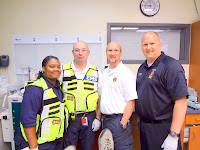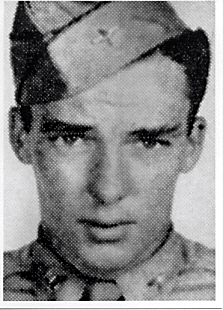 Baltimore Washington International Airport Emergency Plan Exercise (EPLEX) 2011 Saturday, May 7th, 2011 Purpose: EPLEX provides BWI airport and its mutual aid partners the opportunity to test and evaluate the Airport Emergency Plan (AEP), departmental procedures, personnel, and equipment to identify weaknesses, procedural gaps, and best practices.
Baltimore Washington International Airport Emergency Plan Exercise (EPLEX) 2011 Saturday, May 7th, 2011 Purpose: EPLEX provides BWI airport and its mutual aid partners the opportunity to test and evaluate the Airport Emergency Plan (AEP), departmental procedures, personnel, and equipment to identify weaknesses, procedural gaps, and best practices.
Scenario: On Saturday mourning, May 7th at 0900L, Jet Blue Fit DC-10-30 while departing Runway 33L, en route to LGB, sustained catastrophic engine failure to #3 engine, causing aircraft to veer off RWY surface and rest on grass/pavement surfaces West of RWY15R-33L, South of RWY 04-22. Fire and smoke is visible coming from the right side engine/wing.
 By the time the first fire unit arrives on scene, the fire has already started to penetrate and spread into the interior of the tail section. (25) Passengers will succumb to smoke inhalation and burns in the interior of the aircraft. of the (75) persons who escape the aircraft, 915) will suffer moderate to severe smoke inhalation. When triaged, the survivors will consist of (15) "Immediate," (23) "Delayed," and (37) "Minor/Uninjured. (10) of the Uninjured are covered in Jet-A (fuel) and will need to be decontaminated.
By the time the first fire unit arrives on scene, the fire has already started to penetrate and spread into the interior of the tail section. (25) Passengers will succumb to smoke inhalation and burns in the interior of the aircraft. of the (75) persons who escape the aircraft, 915) will suffer moderate to severe smoke inhalation. When triaged, the survivors will consist of (15) "Immediate," (23) "Delayed," and (37) "Minor/Uninjured. (10) of the Uninjured are covered in Jet-A (fuel) and will need to be decontaminated.Goals:
Meet the FAA's Airport Certification Program, Part 139, requirement to hold a full-scale Emergency Planning Exercise (EPLEX) every three years.
Test BWI AEP.

Test the internal and external communication necessary to respond to an e emergency at the airport.
My Reflections as a Player (crash victim with lacerations and a broken arm):
Test BWI AEP.

Test the internal and external communication necessary to respond to an e emergency at the airport.
My Reflections as a Player (crash victim with lacerations and a broken arm):
Note: For comparison, here is the same emergency exercise from 2008.
1. Social media is EVERYWHERE. Victims, responders, American Red Cross workers, BWI Airport employees. MD state troopers, EMTs, firefighters, "family and friends" all players and all emergency management professionals at the exercise...EVERYONE had social media (smart phones with links to Twitter, Twitpic, Facebook, YoiuTube, etc.) available...and used it.
For example, there years ago I played a six-year old child with any eyeball hanging out. The guy with the problem eyeball this year took photos of his injury all day and sent it via text to dozens of people. That's the new world we live in.
Here is a website to help you deal with that reality. Dealing with Social Media in a Crisis
In the real world and in exercises, be ready for your event to go viral...fast. With millions of smart phones out there with cameras and video recorders, much of what you say and do will end up on Twitter, Facebook, YouTube and others.
Only three years ago I wrote an article called Free Web Safety & Emergency Tools for The American Civil Defense Association (TACDA). In it, I presented the case for first responders, emergency management professionals, and policy makers to use free social media, like Twitter, Facebook, You Tube to mitigate, plan for, respond to, and recover from events. I stated:
"All these social media tools are even more powerful
when used together. The new social media will revolutionize your work world."
Judging by the number of "victims" at this exercise who were instantly sharing pictures, videos and words with the larger world, this is a reality that must be taken seriously in all emergency planning these days.
2. We're getting better at emergency management. I've been in and around this field for about 30 years. Many areas that were once haphazard (triage comes to mind) are now better organized and coordinated. The first responders have always been great at providing assistance, but now they have technology and software tools that, when used wisely, save more lives.
For example, a large truck with dozens of high tech stretchers was able to preposition using sophisticated software that connect it to a base mobile communications unit (that looked like something out of Star Trek with all the antennas and satellite dishes).
3. It's all about people. I heard a dozen human stories too long to record here. The technology, as great as it is, must never blind us to the humans behind it, in front of it, using it, and having it used on them.
For example, one women I got to know in the moulage room ended up being a severely injured "victim."
She played the part, very well. When she would scream, many participants and professionals went to her help. Imagine that.

 When she continued to scream at St. Agne's Hospital emergency room, they took it for a few minutes and then were about to give her a sedative. With all that treatment technology in that modern medical room, her screaming got their attention very quickly. It's still about humans, and their behavior, before, during, and after an event.
When she continued to scream at St. Agne's Hospital emergency room, they took it for a few minutes and then were about to give her a sedative. With all that treatment technology in that modern medical room, her screaming got their attention very quickly. It's still about humans, and their behavior, before, during, and after an event.Thanks to the Emergency Management Pros
As always, my thanks to the men and women who do this for a living. I was only a bit player. As such, I had the fun without the responsibility.

When I saw how seriously they approached their tasks, I was filled with admiration and pride. They're good. Very good. And we should never, ever take them for granted.So me and my family to them and their family's...THANKS!
























-001.JPG)


-001.JPG)
.jpg)

.jpg)

-001.jpg)






